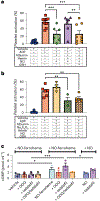Thiol-catalyzed formation of NO-ferroheme regulates intravascular NO signaling
- PMID: 37710075
- PMCID: PMC10897909
- DOI: 10.1038/s41589-023-01413-3
Thiol-catalyzed formation of NO-ferroheme regulates intravascular NO signaling
Abstract
Nitric oxide (NO) is an endogenously produced signaling molecule that regulates blood flow and platelet activation. However, intracellular and intravascular diffusion of NO are limited by scavenging reactions with several hemoproteins, raising questions as to how free NO can signal in hemoprotein-rich environments. We explore the hypothesis that NO can be stabilized as a labile ferrous heme-nitrosyl complex (Fe2+-NO, NO-ferroheme). We observe a reaction between NO, labile ferric heme (Fe3+) and reduced thiols to yield NO-ferroheme and a thiyl radical. This thiol-catalyzed reductive nitrosylation occurs when heme is solubilized in lipophilic environments such as red blood cell membranes or bound to serum albumin. The resulting NO-ferroheme resists oxidative inactivation, is soluble in cell membranes and is transported intravascularly by albumin to promote potent vasodilation. We therefore provide an alternative route for NO delivery from erythrocytes and blood via transfer of NO-ferroheme and activation of apo-soluble guanylyl cyclase.
© 2023. The Author(s), under exclusive licence to Springer Nature America, Inc.
Conflict of interest statement
Competing interests
A.W.D., J.J.R., M.T.G., J.T., M.R.D., D.B.K.-S. and L.P. have a provisional patent filed at the University of Pittsburgh (application no. 63/420,030), related to the creation and use of NO-ferroheme. Though not related directly to NO-ferroheme, A.W.D., J.T., J.J.R., M.T.G., M.R.D. and Q.X. are co-inventors on patents and patent applications directed at the use of heme proteins as therapeutic agents. M.T.G., D.B.K.-S. and J.J.R. are co-inventors on patent and/or patent applications related to sodium nitrite as a therapeutic. Some of these patents are licensed to Globin Solutions, Inc. J.J.R., M.T.G. and J.T. are shareholders of Globin Solutions. J.J.R. and J.T. are officers and directors of Globin Solutions. A.W.D. is a consultant of Globin Solutions. M.T.G. is a consultant, director and scientific advisor to Globin Solutions. The other authors declare no competing interests.
Figures







Update of
-
Thiol catalyzed formation of NO-ferroheme regulates canonical intravascular NO signaling.Res Sq [Preprint]. 2023 Jan 20:rs.3.rs-2402224. doi: 10.21203/rs.3.rs-2402224/v1. Res Sq. 2023. Update in: Nat Chem Biol. 2023 Oct;19(10):1256-1266. doi: 10.1038/s41589-023-01413-3. PMID: 36711928 Free PMC article. Updated. Preprint.
References
-
- Kharitonov VG, Sharma VS, Magde D & Koesling D Kinetics of nitric oxide dissociation from five- and six-coordinate nitrosyl hemes and heme proteins, including soluble guanylate cyclase. Biochemistry 36, 6814–6818 (1997). - PubMed
Publication types
MeSH terms
Substances
Grants and funding
LinkOut - more resources
Full Text Sources
Other Literature Sources

